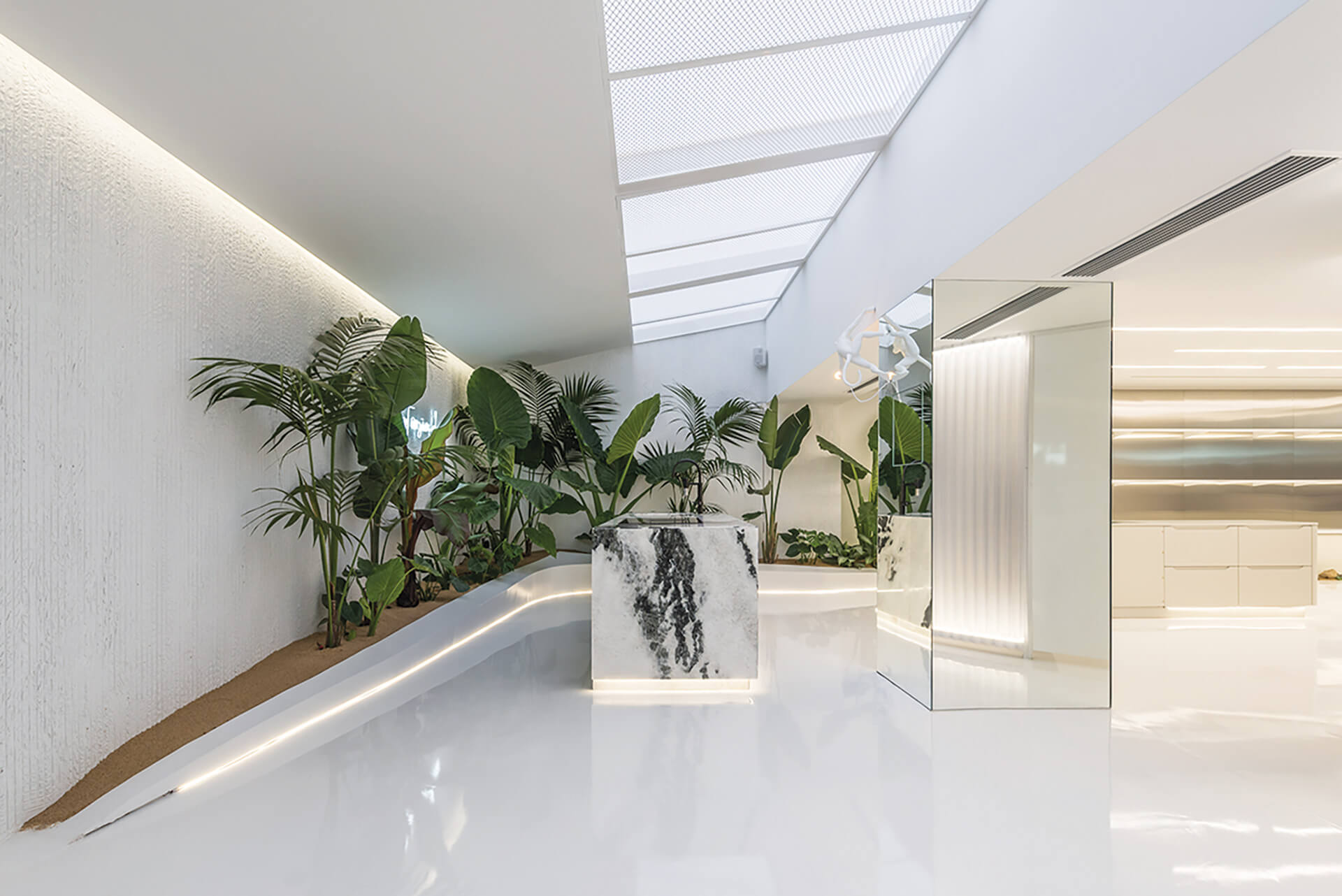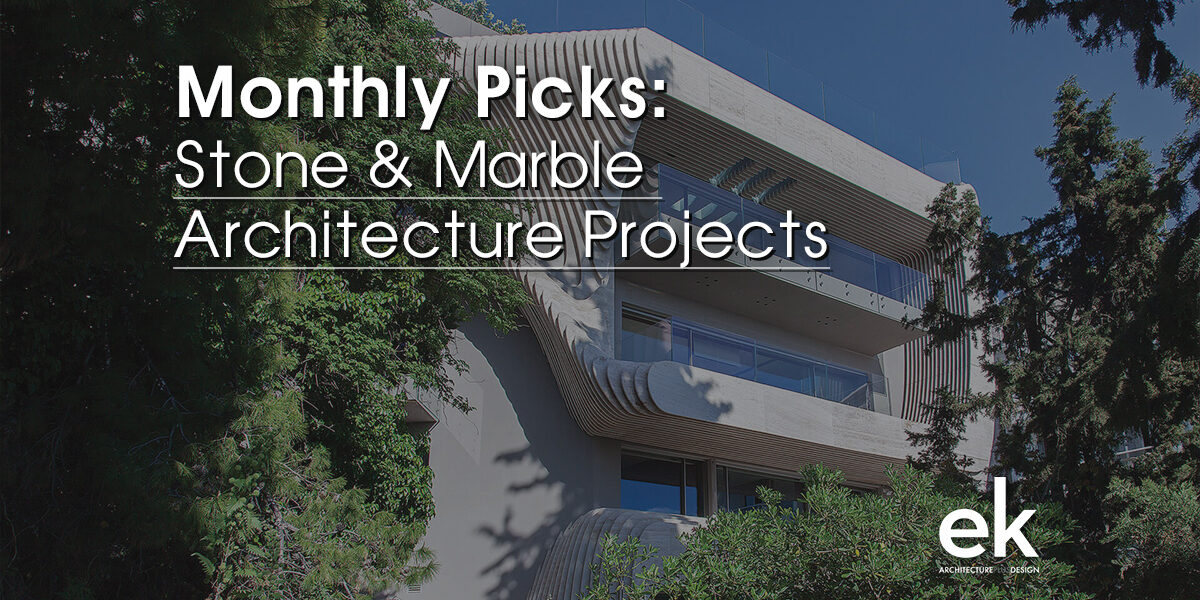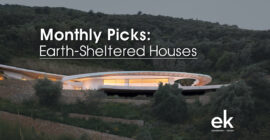The editorial team of ek magazine selected ten architectural projects, featured in past print issues as well as the ek website, showcasing exceptional designs that use stone and marble as primary materials.
One Kleomenous represents an innovative approach to residential architecture. Advanced technologies were employed throughout both the design and construction processes to achieve a result that blends refined aesthetics with practical functionality.
Located on the threshold between the dense urban fabric of Athens and the natural terrain of Lycabettus Hill, the site itself shaped the design approach. The building was envisioned as a bridge between two worlds: the structured, modernist cityscape -with its characteristic forms and materials -and the organic topography of the hill, with its vegetation and earthy textures. The architectural vision sought to create a structure that is both functionally contemporary and contextually integrated. To achieve this, a hybrid design language was adopted- one that embraces innovation while respecting its surroundings.
Aris Konstantinidis once wrote: “…To build spaces for people to live in is no easy task… The architect’s intention must be aligned with the truth of the landscape. I speak of an architecture that grows out of specific soil, absorbing the unique sunlight of each climate in order to evolve. The architect is a poet, whose vocabulary is stone, wood, and metal -a poet of the materials of the Place in which they build…”.
At the heart of the design lies an ethos rooted in habitus -the habits and rituals of daily life. Rather than focusing solely on the building as an object, the design emphasizes the lived experience it creates. The spatial narrative is not simply a picturesque or romantic interpretation of the setting, but a continuous dialogue -an interplay that invites the resident to attune to the conversation between Place (in this case, the ever-present Messinian sea) and contemporary dwelling. This dialogue is expressed through physical qualities: materiality, density, weight, temperature, and acoustics. These are not abstract notions, but tangible, immersive experiences grounded in space and time.
Milos Cove, a contemporary five-star inception resort, stands in serene seclusion, far from the lively rhythms of Cycladic island life. Nestled in the Agkali area on the northeastern edge of Milos, it rises above a site of great archaeological significance -Europe’s largest known prehistoric obsidian workshop. Its only true boundary is the vastness of the Aegean Sea, which it overlooks from the edge of a dramatic cliff, suspended high above sea level.
Here, below Milos’ volcanic rock formations -rich in texture and hue- the landscape speaks in silence yet resonates with a profound sense of mystery. Milos Cove does not seek to overshadow this grandeur but to embrace it fully, allowing the terrain to flow through its design. The resort unveils itself gradually, in a mythical, almost cinematic progression. A steep, rugged road winds between ancient stones that stand like timeless guardians, guiding visitors to a striking first glimpse of the structure framed from above.
 The project centers on the creation of a modern wellness hub arranged over two levels. Its core objective is to seamlessly integrate diverse functions into a unified architectural experience, achieved through a fluid interior layout shaped by the interplay of materials and light.
The project centers on the creation of a modern wellness hub arranged over two levels. Its core objective is to seamlessly integrate diverse functions into a unified architectural experience, achieved through a fluid interior layout shaped by the interplay of materials and light.
Visitors enter through a double-height space illuminated by pendant lighting, where a semi-circular polycarbonate surface guides movement inward. In the retail area, elongated counters, linear ceiling fixtures, and full-length wall shelving emphasize horizontal lines, creating a sense of motion and depth. Toward the back, the space opens up once more through a soft curve, accommodating a lounge and kitchen. Natural light filters in through skylights set in the sloped metal roof, while a mirrored column subtly disrupts the visual field -enhancing the perception of spatial continuity.
The iconic Greek fashion brand Parthenis was founded in 1970, when Dimitris Parthenis opened his first store in Athens. In 1978, Parthenis opened a boutique in Mykonos, which was both a source of inspiration and a stepping-stone for international fame. Parthenis’ minimalist, monochromatic designs are recognised worldwide for their timeless elegance, high quality, and flattering silhouettes. With Orsalia Parthenis, daughter of the founder, at its helm, the brand continues its strong global presence in the world of fashion and design.
The project seeked to transform the label’s flagship store in Mykonos town into a multifunctional space, where customers can shop Parthenis’ instant classics and enjoy a drink, or a light meal inspired by the elemental Cycladic lifestyle. Located next to the island’s famous windmills, the café flows onto a courtyard overlooking Little Venice and its legendary sunsets.
Perched on the hillside above Vourni Beach, the hotel is an architectural intervention that harmonizes with its surroundings, appearing to emerge organically from the earth. The design fosters a continuous dialogue with the landscape, respecting and enhancing the island’s unique beauty while seamlessly blending the built and natural environments.
The design pays homage to the island’s unique beauty, fostering a seamless connection between the built environment and the natural terrain. During the project’s excavations, archaeologists unearthed the remains of a classical-era tower, constructed around the same time as the Parthenon. Further up the slope, remnants of a late Byzantine cellar and scattered Ottoman-era structures were also discovered. These findings reveal a rich historical tapestry, with thousands of years of human presence etched into the very rocks of the hillside.
Today, Odera leaves its mark on this historic landscape. The building’s form embodies a fusion of the harmony of ancient Greek classicism and the strength of Byzantine ecclesiastical architecture. The simplicity of the volumes, inspired by Cycladic tradition, coupled with the use of local materials and forms, ensures that the resort blends seamlessly into both its natural and built surroundings.
 Perched on the hillside above Vourni Beach, the hotel is an architectural intervention that harmonizes with its surroundings, appearing to emerge organically from the earth. The design fosters a continuous dialogue with the landscape, respecting and enhancing the island’s unique beauty while seamlessly blending the built and natural environments.
Perched on the hillside above Vourni Beach, the hotel is an architectural intervention that harmonizes with its surroundings, appearing to emerge organically from the earth. The design fosters a continuous dialogue with the landscape, respecting and enhancing the island’s unique beauty while seamlessly blending the built and natural environments.
The design pays homage to the island’s unique beauty, fostering a seamless connection between the built environment and the natural terrain. During the project’s excavations, archaeologists unearthed the remains of a classical-era tower, constructed around the same time as the Parthenon. Further up the slope, remnants of a late Byzantine cellar and scattered Ottoman-era structures were also discovered. These findings reveal a rich historical tapestry, with thousands of years of human presence etched into the very rocks of the hillside.
Today, Odera leaves its mark on this historic landscape. The building’s form embodies a fusion of the harmony of ancient Greek classicism and the strength of Byzantine ecclesiastical architecture. The simplicity of the volumes, inspired by Cycladic tradition, coupled with the use of local materials and forms, ensures that the resort blends seamlessly into both its natural and built surroundings.
Living amidst the rapid growth of urban population and high rises in Bangkok, a critical question is raised: how can we adjust ourselves to live peacefully and privately in this speedily changed environment and lifestyles? In doing so, how can we avoid losing contact with the amenities that megacity provides us and accessibility to the greenspace?
The project proposes an alternative design solution to mitigate this urban-dwelling problematic issue by crafting the home-office buildings called “THE Haute”, a self-sustainable workplace and residence, to become a new solution concept for the next generation of housing development in Thailand. The building concept is begun with simple idea as stacked boxes, between black stone box and aluminum box. These boxes are composed of two main functions as the working space and living space. The openable windows are designed for not facing each other, for reasons of privacy.
The residence is nestled into the hillside, following the topographical contours and adapting seamlessly to the natural morphology of the land. It is situated in the area of Louria, in the southern part of Paros. The plot is oriented to the southwest along its longer side, offering unobstructed views of the sea, the bay of Aliki, and Antiparos.
The entrance is located on the northern edge of the site, where the highest point serves as a gateway into the home. A solid white wall with minimal openings greets the visitor, concealing both the internal arrangement and the front courtyards. The architectural composition is defined by a series of spatial and experiential dualities: concealed versus exposed spaces, sheltered courtyards versus open terraces, interior circulation paths versus threshold journeys, a closed entrance versus an unfolding route, grounded volumes embedded in the landscape versus elevated masses reaching toward the view. Large transverse walls extend from the core of the residence into the hillside, anchoring the building to the terrain. These walls carve out private courtyards at the rear and guide the interior spaces outward into the natural surroundings.
The project is inspired by a special feature of Mani’s residential forms – the “Ksemonia”, meaning “the ones left alone”; those were stand-alone towers or small residential complexes in the rugged landscape of Mani, operating as shelters or observation points. From afar, these stone-built towers appear as just one more element in the land, like monolithic outbursts from the soil.
The residential compound, consisting of two stone houses, is organized around two towers placed in the plot in a dynamic arrangement which correlates the outdoor spaces and the house entrances, further defining additional outdoor areas. The modern tower-houses are designed to be in close connection with the natural landscape, just as is the case with traditional Mani architecture, which became an integral part of the place it sprung out of. Although the main composition is expressed in the form of the towers, their extensions, which make up the rest of the complex, do not exist independently within the plot, but are rather brought together into a whole, echoing the established architectural forms of the region; in so doing, they also provide a modern interpretation of those same traditional typologies.













